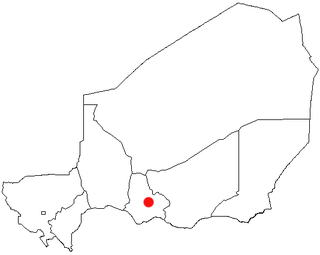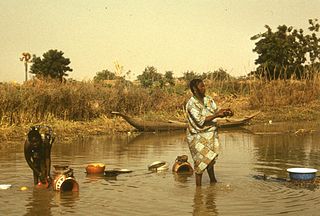
The Region of Maradi is one of seven regions of Niger. It is located in south-central Niger, east of the Region of Tahoua, west of Zinder, and north of the Nigerian city of Katsina. The administrative centre is at Maradi. The population of the Region is predominantly Hausa.

Madaoua is a town and urban commune located in the Tahoua Region of Niger. It has a population of 127,254. It is seat of the Madaoua Department, forming the southwest corner of the Region, and is an Urban Commune.

Gaya is a city in the Gaya Department of the Dosso Region of Niger. The city is situated 254 km southeast of the capital, Niamey, is located on the banks of the Niger River, and is near the borders with Benin and Nigeria. Gaya has a population of 63,815. The wettest area in Niger, Gaya averages 800 mm in rainfall a year.

Mayahi is a town located in the Maradi Region of Niger. It is the seat of Mayahi Department and a Commune about 45 km from Tessaoua. In 2012 it had a population of 14,000 in the urban area. The name "Mayaki" is also a rulers' title among the Sudié and Maouri: local subgroups of the Hausa people.

Téra is a city in the Tillabéri Region, Tera Department of Niger. It is situated 175 km north-west of the capital Niamey, close to the border with Burkina Faso. It is mainly inhabited by Songhai, Fulani, Gourmantche and Buzu ethnic groups. The majority of the population are farmers.
The Waki is a river in western French Guiana. It is a right tributary of the Tampok. It is 147 km (91 mi) long. The river has its source as the confluence of the southern Grande Waki which has its source in the Arawa Mountains, and the northern Petite Waki which has its source in the Sommet Tabulaire.

The Departments of Niger are subdivided into communes. As of 2005, in the seven Regions and one Capital Area, there were 36 départements, divided into 265 communes, 122 cantons and 81 groupements. The latter two categories cover all areas not covered by Urban Communes or Rural Communes, and are governed by the Department, whereas Communes have elected councils and mayors. Additional semi-autonomous sub-divisions include Sultanates, Provinces and Tribes (tribus). The Nigerien government estimates there are an additional 17000 Villages administered by Rural Communes, while there are over 100 Quartiers administered by Urban Communes.

The French National Research Institute for Sustainable Development, or Institut de Recherche pour le Développement (IRD), is a French science and technology establishment under the joint supervision of the French Ministries of Higher Education and Research and Foreign Affairs. It operates internationally from its headquarters in Marseille, and two metropolitan centres of Montpellier and Bondy.

Karma is a town and a rural commune in southwestern Niger, near the city of Niamey. The town had a population of 8,505 at the 2012 census, while the commune had a population of 88,244.
Illela, Niger is a town and urban commune in Niger.
Magaria is a town and urban commune in the magaria bande of the Zinder Region of Niger.
Mirriah is a town and urban commune in Niger.
Abala, Niger is a village and rural commune in Niger.
Garhanga is a village and rural commune in Niger. It is located in the Keita Department of the Tahoua region. As of 2012, it has a population of 69,712.
Tarka, Niger is a village and rural commune in Niger. It is located in the Belbédji Departement of the Zinder Region. As of 2012 the commune had a population of 96,452.
Tondikandia is a rural commune in Filingué Department, Tillabéri Region, Niger. Its chief place and administrative center is the town of Damana.
Matameye is a town and urban commune, administrative centre of the Matameye Department in Niger, with a total population of 64,988 as of 2012 with 27,615 living in the town. In 2005 a road was completed from Matameye to Takieta. Since 2011 many people have moved to Matameye from Tânout and Gouré because of the food crisis, in search for better harvests, abandoning their homes and schools.
Sikié is a Songhai town near Namaro in Niger. Sikié was the place where the defeated Songhai Empire army led by Askia Muhammed Gao installed their base hoping for a possible passage of the Moroccan army.
Liongo is a village in the Buea Subdivision in the Fako Division of the South West Region of Cameroon.

Iferouane is a department of the Agadez Region in Niger. Its administrative seat is the city of Iferouane. As of 2012, the department had a total population of 32,731 people.











